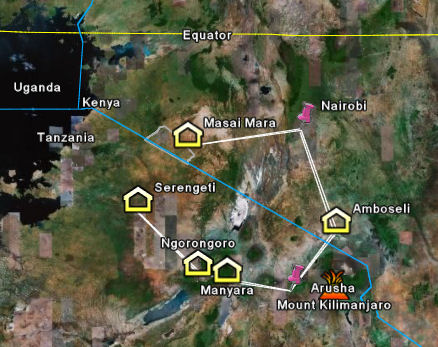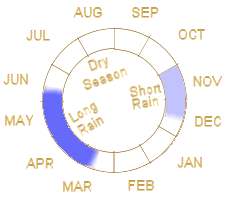DECEMBER, JANUARY, FEBRUARY, MARCH The Serengeti National Park / Ngorongoro Conservation Area is arguably the most impressive wildlife sanctuary in the world. During the months December through March the seemingly unending plains of the southern Serengeti and the Conservation Area are inhabited by enormous herds of wildebeest and zebra. The great herds graze on rain ripened grass. In the calving season (late January through mid March) the herds concentrate at the Ndutu and Salei plains (Southern Serengeti / Ngorongoro Conservation Area) attracting the attention of predators like lion, cheetah and hyena…
APRIL, MAY During the months April and May the depleted plains are unable to sustain the endless herds. The migration, sweeping west and north, moves from the short grass plains of the southern Serengeti / Ngorongoro Conservation Area to the long grass plains and woodland of the Serengeti’s western Corridor, almost to Lake Victoria. This period is during the long rains and is considered off season for wildlife viewing in east Africa as roads are often impassable…
JUNE By the end of May the wildebeest have exhausted the Western Corridor’s best pastures and the herds must move further north. Entering the Lamai Wedge and the Mara Triangle breeding occurs May through June. This is a transitional period between the rains and the dry season.
JULY, AUGUST, SEPTEMBER, OCTOBER By July the countless herds have amassed along the swollen Mara River – a final barrier from the short sweet grasses of the Masai Mara. Sometimes the crossing place they have chosen is shallow allowing the majority of animals to pass safely. In other areas the waters boil with drowning wildebeest and slashing crocodiles. Between July and October the wildebeest reside in the Mara.
NOVEMBER The arrival of the short rains call the migration southward. As November ends the migration is making its way back to the southern Serengeti and early in the year they once again give birth. The circle of life is complete.

A photographic safari to Africa is no light undertaking. It’s expensive, many time zones away, and something like gruelling. One is either bouncing on the difficult dirt roads between places, or bouncing on the difficult roads in places on "game drives" [that start very early in the morning]. And at least one of us caught a killer cold on the third day [me]. After two nights in Nairobi, we drove to Masai Mara, a game park in Kenya, where we stayed for three nights. We flew back to Nairobi then drove to Amboseli [the dried up salt lake in the shadow of Kilimanjaro with the swamps] for two nights. Then there was a long drive into Tanzania to the jungle/forest around Lake Manyara for two nights. That was followed by a long drive to Serengeti for another two nights. We ended our travels with two nights at the amazing caldera known as the Ngorongoro Crater, then had another forced march to Nairobi for a night prior to leaving.
The point was to see "the Migration." While I’d seen the Discovery Channel versions, and the recent Planet Earth episode, I had only an embryonal understanding of the phenomenon. The Africans use the term "the Migration" in two main ways. First, it means what I assumed it meant – the movement of the animals. But there was another usage – the animals that move. So they would say, "the Migration is in Masai Mara" – meaning, that’s where the herds are grazing right now. There’s even another meaning. These animals migrate even when they’re in a given place [see the pointers in the animation above].
The main thrust of "the Migration" involves huge herds of Zebras and Wildebeasts [Gnu] that move together in a symbiotic relationship. They don’t all move. Each place we visited had large resident herds of both species – though in the place where "the Migration" was [on our visit, Masai Mara], the herds weren’t just large, they were vast – scattered across the huge plain constantly grazing. They weren’t the only herds. There were large herds of Buffalo too. The Antelopes and Gazelles were spread throughout, more in groups than herds [small bites but lots of them]. Buffalo, Antelopes, Gazelles, Elephants don’t consistently move with the Gnu and Zebra [but some do]. I expect that all of this would be clearer if one devoted a lifetime of study to the place.
Seasons in Africa are very different from this part of the world. We kept talking about Winter, Spring, Fall, and Summer, and the guides constantly retranslated what we said into Short Rains, the Long Rains, and the Dry Season[s] – the seasons that organize Equatorial African life and drive the endless migration of the "eating machine" known as "the Migration." The Wildebeasts and Zebras aren’t the only eaters. Elephants are big consumers, eating 400 pounds a day each [70 tons a year]. The Antelopes and Gazelles take their share too [smaller bites, but lots of them]. Predators [Hyena, Lions, Cheetah, Leopards, Vultures] tend to stay put, making do with what wanders their way.
 Want to get a good laugh in Africa? Try giving them the George W. Bush line about Global Warming – that it’s not happening or that it’s not caused by our hands. They burst into laughter. They’ve lived by the seasonal clock on the left forever, and that clock isn’t working like it used to. "We had rains all of January! Anyone can see the climate is changing. Even the Maasai in the deepest desert knows what’s going on!" And the laughter continues… Want to get a good laugh in Africa? Try giving them the George W. Bush line about Global Warming – that it’s not happening or that it’s not caused by our hands. They burst into laughter. They’ve lived by the seasonal clock on the left forever, and that clock isn’t working like it used to. "We had rains all of January! Anyone can see the climate is changing. Even the Maasai in the deepest desert knows what’s going on!" And the laughter continues… |
Sorry, the comment form is closed at this time.